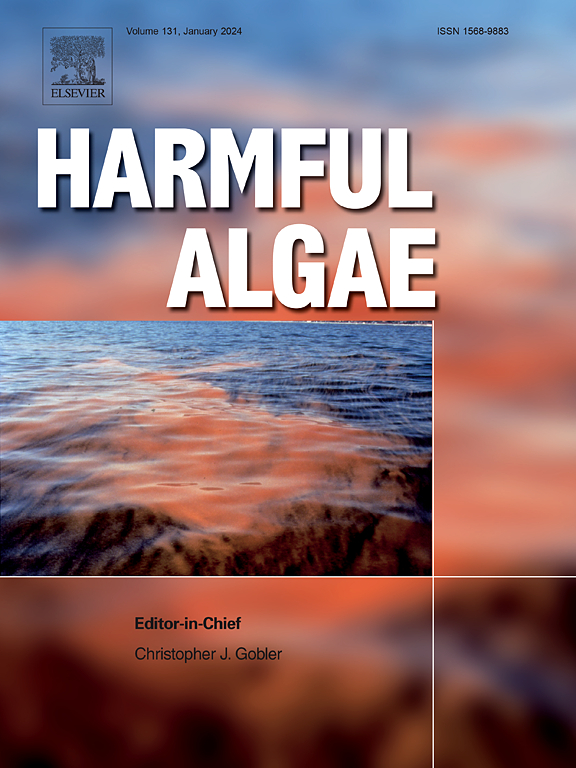Kareniaceae in focus: A molecular survey of harmful algal dinoflagellates in the South China Sea
IF 4.5
1区 生物学
Q1 MARINE & FRESHWATER BIOLOGY
引用次数: 0
Abstract
In recent years, species of the family Kareniaceae have been forming algal blooms worldwide, leading to significant fish mortality. The biodiversity of this group of dinoflagellates has been underestimated, primarily due to their highly similar morphologies. In this study, using high-throughput sequencing (HTS) targeted the large subunit ribosomal DNA (LSU rDNA) of dinoflagellates, 21 Kareniaceae species were identified from the South China Sea (SCS), including nine species newly recorded in Chinese coastal waters. Additionally, species-specific real-time fluorescent quantitative PCR (qPCR) assays targeting the internal transcribed spacer (ITS) for three Karenia species (Karenia longicanalis, K. papilionacea, and K. selliformis) isolated from the SCS were established. Karenia longicanalis and K. papilionacea were identified as the most prevalent Karenia species in summer in the Zhujiang Estuary via qPCR. Further qPCR analysis during a Karenia spp. bloom in the Beibu Gulf on August 3, 2023, revealed K. selliformis as the most abundant species, followed by K. longicanalis, K. mikimotoi, and K. papilionacea. Both HTS and qPCR methods successfully detected the targeted Karenia species in field samples; however, qPCR assays identified them at more stations than HTS. The integration of qPCR assays with HTS provides a comprehensive and precise assessment of the diversity of Kareniaceae species and harmful dinoflagellates. This multi-method approach enhances our understanding and management of harmful algal blooms, thereby contributing to the improved protection of marine ecosystems.
聚焦念珠菌科:南海有害藻鞭毛藻的分子调查
近年来,卡伦藻科的物种在世界各地形成藻华,导致大量鱼类死亡。这一类甲藻的生物多样性一直被低估,主要是因为它们的形态高度相似。本研究利用针对甲藻大亚基核糖体 DNA(LSU rDNA)的高通量测序技术(HTS),从中国南海(SCS)鉴定出 21 个甲藻科物种,其中包括 9 个在中国近海水域新记录到的物种。此外,针对从南海分离的三个卡伦氏藻(Karenia longicanalis、K. papilionacea 和 K. selliformis)的内部转录间隔(ITS),建立了物种特异性实时荧光定量 PCR(qPCR)检测方法。通过 qPCR 分析,确定 Karenia longicanalis 和 K. papilionacea 是珠江口夏季最常见的 Karenia 种类。在 2023 年 8 月 3 日北部湾卡伦氏藻水华期间,进一步的 qPCR 分析表明,K. selliformis 是最多的物种,其次是 K. longicanalis、K. mikimotoi 和 K. papilionacea。HTS 和 qPCR 方法都成功地检测到了野外样本中的目标卡伦氏菌物种;但是,qPCR 检测方法比 HTS 方法在更多的站点发现了这些物种。将 qPCR 检测方法与 HTS 方法相结合,可对卡伦藻属物种和有害甲藻的多样性进行全面而精确的评估。这种多方法方法增强了我们对有害藻华的了解和管理,从而有助于更好地保护海洋生态系统。
本文章由计算机程序翻译,如有差异,请以英文原文为准。
求助全文
约1分钟内获得全文
求助全文
来源期刊

Harmful Algae
生物-海洋与淡水生物学
CiteScore
12.50
自引率
15.20%
发文量
122
审稿时长
7.5 months
期刊介绍:
This journal provides a forum to promote knowledge of harmful microalgae and macroalgae, including cyanobacteria, as well as monitoring, management and control of these organisms.
 求助内容:
求助内容: 应助结果提醒方式:
应助结果提醒方式:


